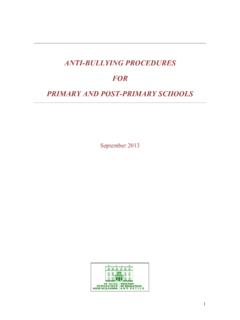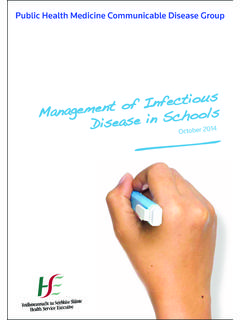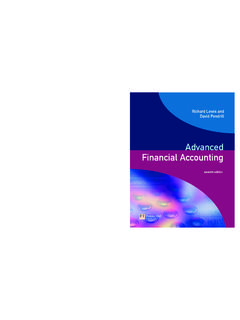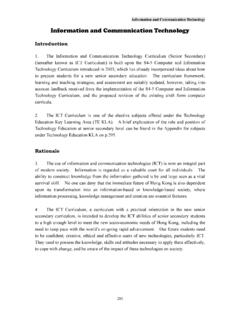Transcription of A Brief Description of the Irish System - Welcome to the ...
1 A Brief Description of the Irish Education System Education System in Ireland Pre-primary education (ISCED 0). Primary education (ISCED 1). Junior Cycle of secondary level (ISCED 2). Senior Cycle of secondary level (ISCED 3). Further courses (ISCED 4). Third Level Certificate/Diploma courses (ISCED 5b). University degree/Postgrad (ISCED 5a). PHD (Doctorate) (ISCED 6). A Brief Description Of the Irish Education System This document is intended as a Brief guide to the Irish Education System . Further information may be obtained on the Department's website Published by Communications Unit Department of Education and Science January 2004.
2 Contents Contents Page No Introduction 5. First Level Education (Primary) 9. Second Level Education (Post-Primary) 13. Third Level Education 17. Further and Adult Education 21. Administrative Framework 23. Special Education for Students with Disabilities 27. Tackling Educational Disadvantage and Promoting Social Inclusion 29. Promoting Science and Technology in Education 31. Appendix A: Bodies Under the Aegis of the Department 33. Appendix B: Education Legislation Since 1924 34. Appendix C: Contact Details 36.
3 3. Introduction Introduction E. ducation has always been highly valued in Ireland. Even in historic times of great political, economic and social difficulty, the desire for education was very much in evidence. Prior to the establishment of a national System of primary education in 1831, there was already in existence a vast network of schools, the great majority of them provided by a people who had been dispossessed of their lands and who were experiencing harsh penal legislation. In later times, whenever opportunities for education were provided, Irish people were quick to utilise and take advantage of them.
4 During the seventeenth and eighteenth centuries, the prevailing political and social climate meant that many Irish people had to go abroad to access higher education, using the Irish Colleges network. This debt was more than repaid later by the great diaspora of Irish scholars, teachers and missionaries to the English-speaking world over the last two centuries. Education is now regarded as a central plank in the economic, social and cultural development of Irish society. Governments and the social partners view it as strategically interlinked with national planning.
5 There is a high level of public interest in educational issues, which has been further developed by the consultative approach adopted by the Government in the formulation of education policy. Irish pupils perform in the top sectors in international studies such as the Organisation for Economic Co-operation and Development (OECD) PISA. evaluations. Employers, both national and international, affirm the quality of graduates from the Irish education System . Education in Ireland is compulsory from age 6 to 16 or until students have completed three years of second level (post-primary) education.
6 While there is no national provision for pre-schooling in Ireland, first level schools accept children on or after their 5. fourth birthday. The typical first level school enrols pupils by age into eight year-groups or classes, ranging from junior infants to sixth class. The vast majority of schools are State funded, privately owned "all-through" schools, catering for pupils from 4 to 12. years of age. The curriculum followed is a child-centred one and it allows for flexibility in timetabling and teaching methods.
7 The great majority of pupils transfer to second level school when they have completed the full first level course generally at about 12 years of age. For registration in a second level school, students must be aged 12 on 1 January in the first year of attendance. The second level education sector comprises secondary, vocational, community and comprehensive schools. While each category of school evolved from a distinctive historical context, and have different ownership and management structures, they have a great deal in common.
8 They are largely State funded and follow the same State prescribed curriculum and take the same State public examinations. The second level school span is predominantly a six-year cycle, taken by ages 12 to 18. The terminology of "lower secondary" and "upper secondary" is not used in Ireland, but the terms "Junior Cycle" and "Senior Cycle" are commonly used. Apart from internal school tests, there are two key public examinations taken by students the Junior Certificate (age 15/16) and the Leaving Certificate (age 17/18).
9 These are external examinations set by the State Examinations Commission. A great deal of public attention is focused on the Leaving Certificate Examination as entry to third level education is closely linked to the results achieved by students at this examination. Third level education in Ireland is provided mainly by universities, institutes of technology and colleges of education. In addition, a number of other third level institutions provide specialist education in a number of professions such as medicine and law.
10 Most third level education institutions are supported very substantially by the State. For young people and adults who have left education early or without adequate qualifications, second-chance and alternative programmes are available. Adult, further and community education all have a role to play in providing second-chance education opportunities, addressing skills needs and promoting equality and social inclusion. 6. Introduction Many aspects of the administration of the Irish education System are centralised in the Department of Education and Science.














